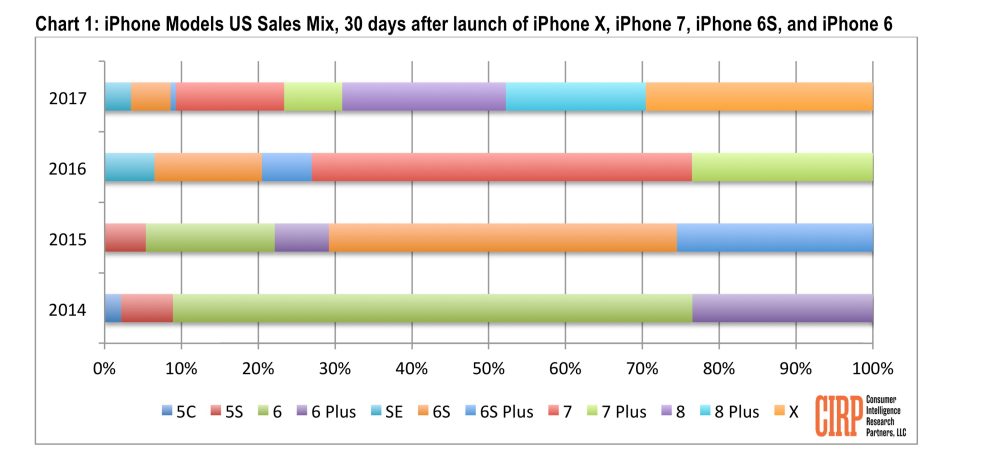 2047
2047
 2017-12-28
2017-12-28
While Apple has yet to breakdown just how many iPhone X units it has sold so far, that hasn’t stopped analysts from taking a stab at it. Today, Consumer Intelligence Research Partners (CIRP) is out with a new investor note in which it attempts to offer some color on the breakdown of how each iPhone model sold during the first month of iPhone X availability…
CIRP’s research, which analyzes the first 30 days of iPhone X sales, shows that the device accounted for roughly 30 percent of total iPhone sales. The iPhone 8 and iPhone 8 Plus combined counted for around 40 percent of sales, with the former coming in at around 23 percent and the latter around 17 percent.
Notably, the iPhone 7 and iPhone 7 Plus captured around 20 percent of sales, despite being over a year old at this point. For comparison’s sake, the iPhone 7 and iPhone 7 Plus accounted for over 70 percent of sales during the first month of availability last year. This data echoes similar analytics information earlier this month.

CIRP explains that it’s hard to know whether the iPhone X met, exceeded, or missed expectations during the first month of availability as Apple has never launched three flagship phones like this. Seeing that this data is from the first month of availability, it’s possible that supply constraints limited iPhone X sales, as all supply worries are essentially gone at this point.
Ultimately, CIRP expects “some disappointment” given the iPhone X’s publicity:
“It’s difficult to say whether iPhone X met, exceeded, or missed expectations, since Apple has never launched a phone in this way before,” said Josh Lowitz, CIRP Partner and Co-Founder. “Based on the heightened publicity, we suspect some disappointment, with iPhone X accounting for less than one-third of US unit sales immediately following the launch. Of course, early supply constraints may have diminished sales, although as of now supply appears plentiful.”
Furthermore, CIRP explains that some buyers may have been holding out to see consumer response to the iPhone X and ultimately went for the more affordable models instead:
“In addition, we think that some delayed iPhone 8 and 8 Plus demand contributed to the situation. After Apple announced the new phones in September, iPhone buyers waited to buy anything until after the release of the iPhone X. They evidently wanted to see what a thousand-dollar phone looks and feels like, and then in many cases bought the seven hundred dollar phone.”
During Apple’s last earnings call, Tim Cook explained that even the company itself was unsure of what to expect in terms of selling breakdowns due to the fact that it has never launched three flagship devices in this sort of sequence. We’ll have to wait for Apple’s upcoming earnings call in late January for its thoughts.
Source: 9to5mac